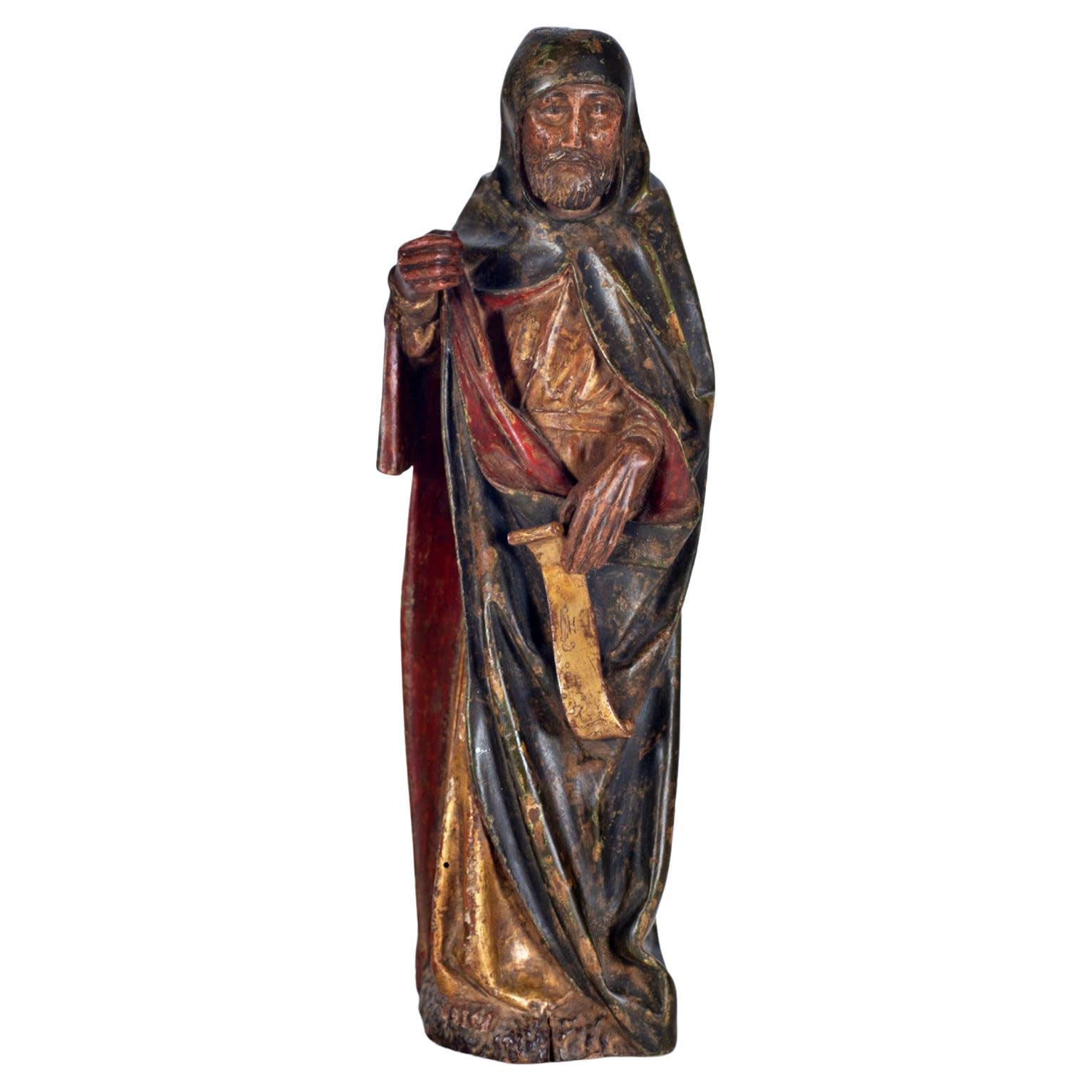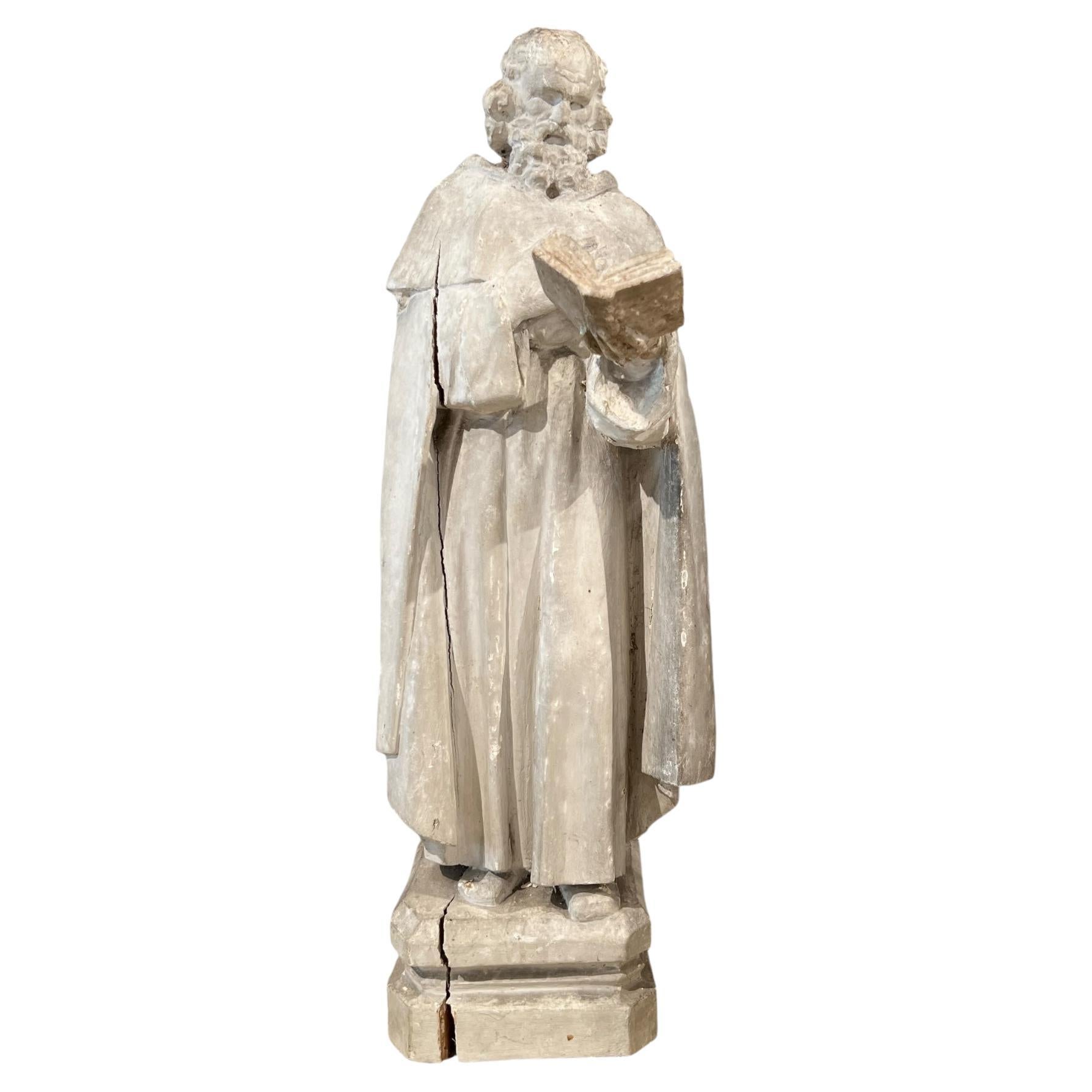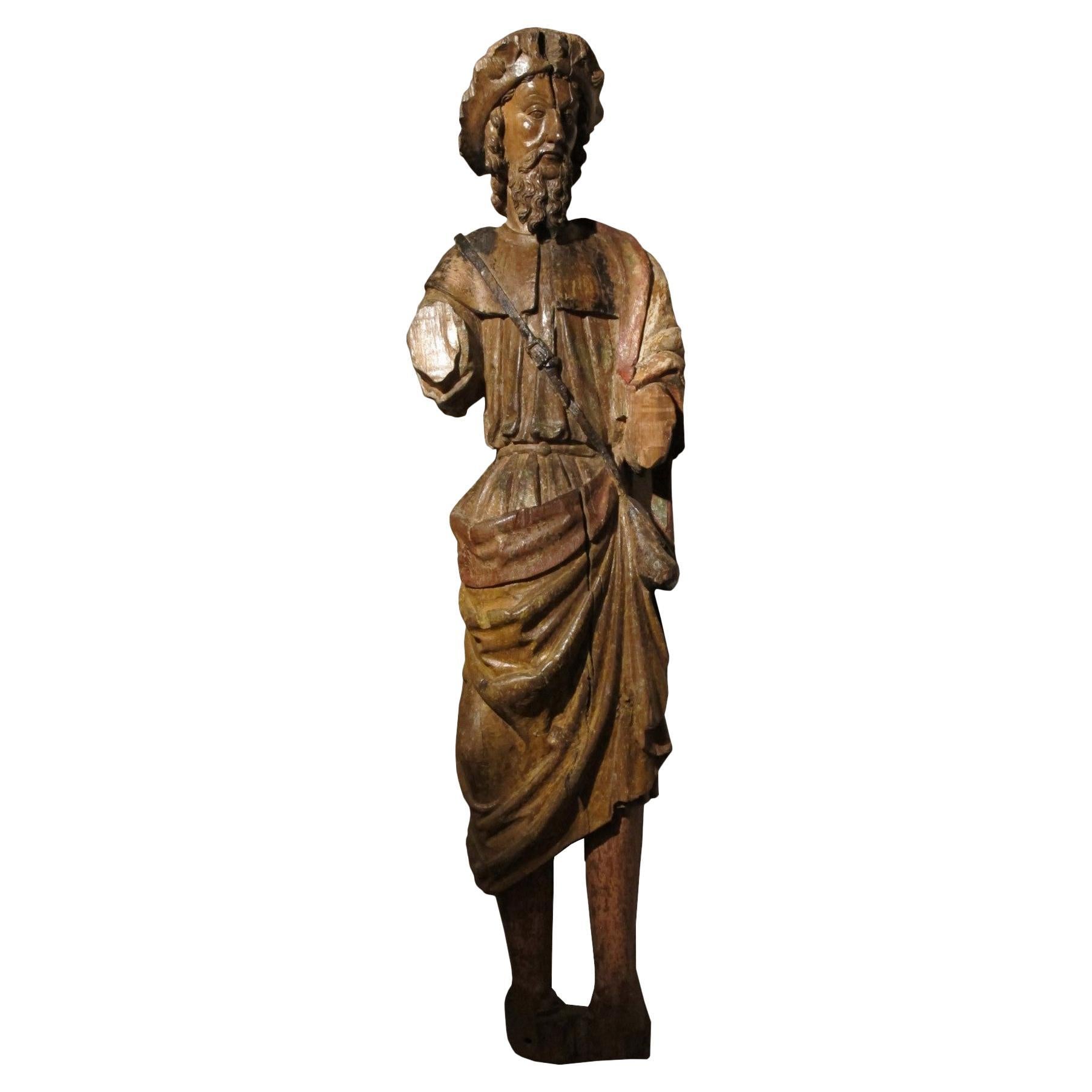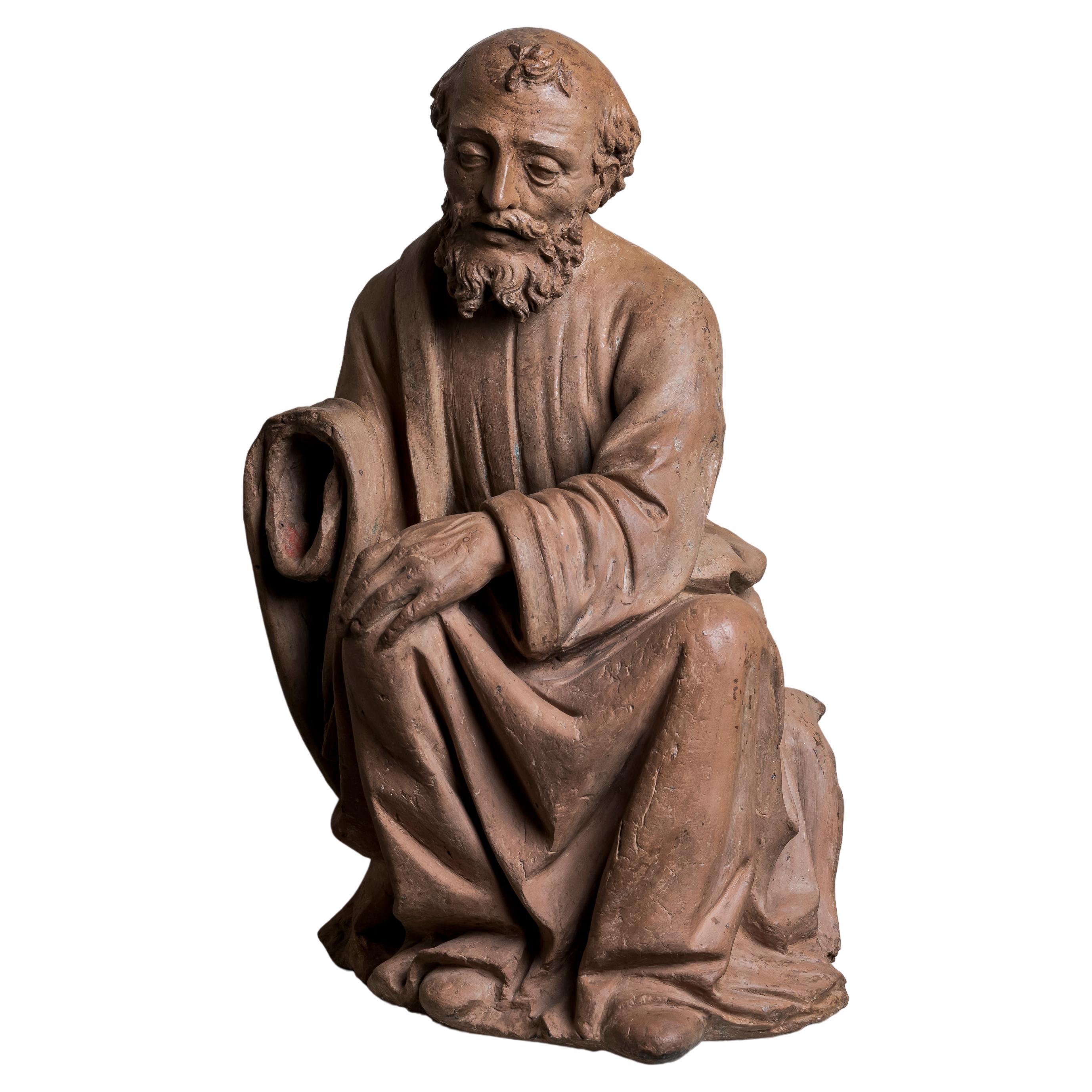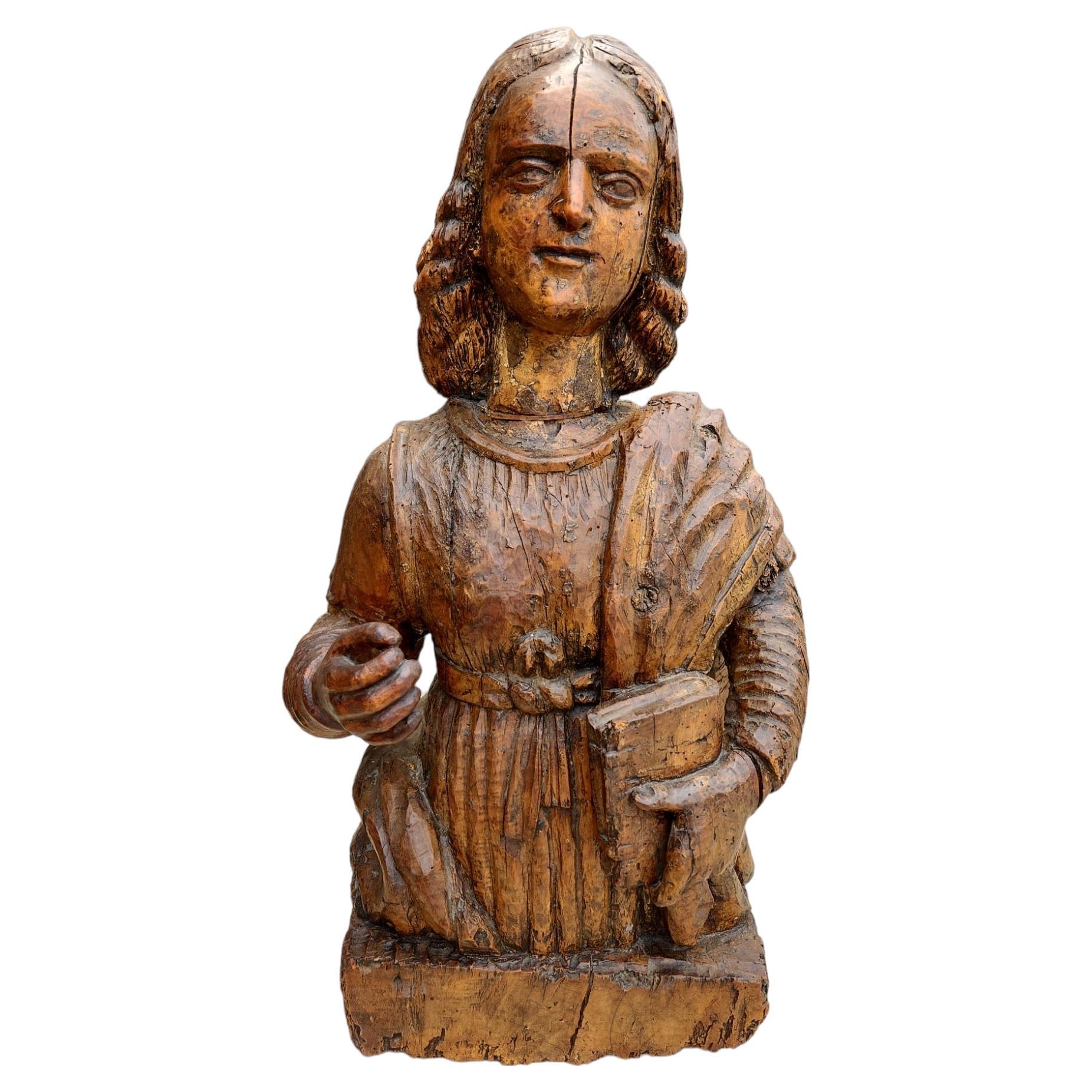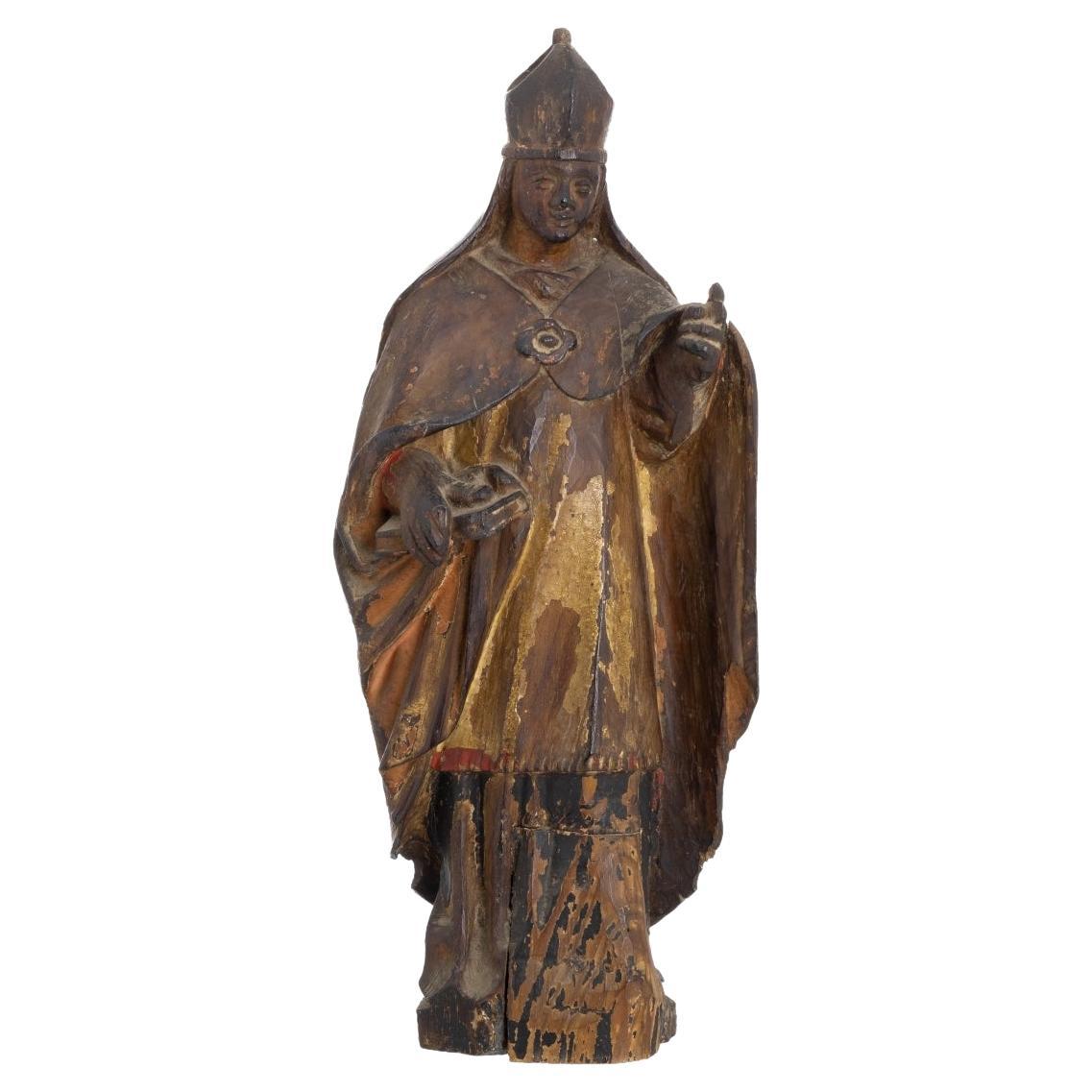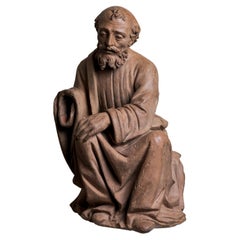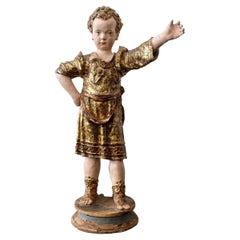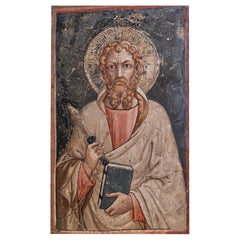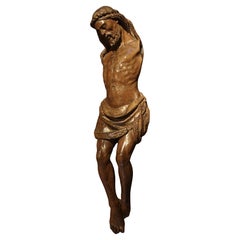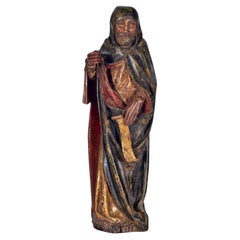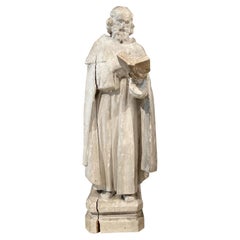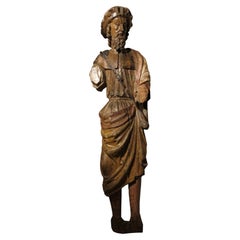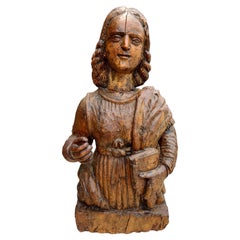Items Similar to Circle of Pierpaolo and Jacobello Dalle Masegne (Venice, late 14th century)
Want more images or videos?
Request additional images or videos from the seller
1 of 6
Circle of Pierpaolo and Jacobello Dalle Masegne (Venice, late 14th century)
$77,539.23
£57,325.76
€65,000
CA$106,654.05
A$118,552.60
CHF 62,142.73
MX$1,447,814.14
NOK 775,816.17
SEK 729,898.29
DKK 494,843.92
About the Item
Circle of Pierpaolo and Jacobello Dalle Masegne (Venice, late 14th century)
San Bartolomeo
high relief 'en applique'
white marble
52 x 30 x 14 cm
Provenance :
Collection South of France since 197O
Probably « estense » collection, previous Obizzi Collection, 18th century
The imposing male figure, characterized by a long beard and receding hairline, holds an elaborately bound gospel book in his left hand. His right hand, notably missing the tip of the index finger, is oriented vertically as if grasping an object, likely a metallic knife. While it is conceivable that the saint may have held a palm leaf, a universal attribute of martyrs, or even a sword, commonly associated with Saint Paul, the form of the grip suggests otherwise. Specifically, the hilt and guard of a sword would necessitate a different orientation. Likewise, the pen, a symbol of Saint John the Evangelist, can be dismissed due to the manner in which it is traditionally held. Additionally, the beards of both Paul and John the Baptist are usually depicted with pointed ends.
For comparative purposes, it is worth mentioning the marble polyptych of San Francesco in Bologna, created by the Dalle Masegne brothers from 1388 onwards. In this work, the three-quarter figure of San Bartolomeo holds a closed book in his left hand while grasping a long, metallic knife in his right hand in a similar manner. Another relevant comparison can be made with the full-figure marble statue of the apostle in the iconostasis of the presbytery of San Marco in Venice, completed by the same artists in 1394. Here too, the apostle is portrayed with the same dual attributes, albeit with a less firm grip on the knife.
Given the variations in the physical characteristics and attributes associated with Bartolomeo in Western iconography, as evidenced by the aforementioned sculptures by the Dalle Masegne brothers in Bologna and Venice, it is reasonable to conclude that the figure likely represents San Bartolomeo.
The head of the sculpture is intricately crafted, whereas the rest of the body is primarily detailed only at the front. The back is largely smoothed over, with lime integrated into the upper area, save for the bottom portion which is irregularly chiseled. A modern iron hook, affixed with cementitious material, is embedded in a purposefully drilled cavity at the center of the sculpture's back. Additionally, the bald crown of the head retains a fragment of an iron pin or hook, secured in a similar fashion.
The folded drapery of the toga near the bottom reveals a noticeable gap. This is likely a consequence of the rough reworking on the lower part of the back, possibly resultant from a fall. Nonetheless, the rounded contour of the lower drapery suggests that the sculpture was always intended to be a truncated figure, representing only the upper three-quarters of the body. The back's smoothed surface also appears to be largely original, indicating that the sculpture was initially conceived as a high relief meant to project from a background. This background was likely attached to the sculpture using a pin. The design of the high relief as a distinct entity from its background facilitated its detachment and decontextualization.
The concept of a three-quarter sculpture cut above the knees was absent in Greco-Roman artistry, which predominantly offered busts in classical portraits and half-figures with arms for plebeian and provincial portraiture. Giovanni Pisano is recognized for pioneering an extension to the lower half of the Madonna with Child figures (often referred to as the "Madonna del Colloquio") and the Prophets. These innovative sculptures, created in the 1270s for a portal of the Cathedral and the external ring of the Baptistery in Pisa, are now housed in the Cathedral's museum. The extension aimed to imbue the exterior sculptures with greater dynamism, enhancing their visibility when viewed from below. This inventive approach was subsequently echoed in the polyptychs of early 14th-century masters like Giotto, Duccio, and Simone Martini. In these works, the half-figures of the Madonna with Child and the Saints appear slightly elongated in comparison to their Middle Byzantine predecessors, occasionally featuring a small section of garments just below the waist.
The original style of depicting figures with a cut above the knees was revived in 1320 by Pietro Lorenzetti. This technique is evident in his polyptych for the Church of Santa Maria in Arezzo, where it is employed in both the Madonna and Child as well as the three-quarter figures of the Saints in the remaining three registers. Subsequently, Tino di Camaino incorporated this approach into his marble triptychs produced during his Neapolitan period (1324-1336). Examples include the piece formerly part of the Borletti collection, which features the Madonna and Child flanked by Saint Catherine of Alexandria and Saint John the Baptist. The faces of these two saints are currently housed in the Monte dei Paschi collection in Siena—now the Museum of San Donato—and the Salini collection at Gallico Castle near Asciano. Additionally, sporadic instances of this style can be found in panels at the Badia della Cava de' Tirreni and in the Loeser collection at Palazzo Vecchio in Florence.
In the Veneto region, this particular technique of cutting figures above the knees was sparingly utilized during the 14th century. There is a noticeable Tuscan influence, as seen in the reliefs of Saint Luke and Angels on the sarcophagus of Saint Luke in Santa Giustina in Padua, dated to 1316. I attribute this work to an unidentified Florentine sculptor.
In the mid-14th century, sculptor Andriolo de' Santi and painter Paolo Veneziano were influenced by Tuscan artistic trends of the time, notably adopting a three-quarter-length figure rather than the conventional half-figure portrayal. This stylistic choice is evident in the upper registers of various polyptychs, such as Francesco Bissolo's 1357 work for the church of Sant'Antonio Abate in Venice, which is now housed in the Gallerie dell'Accademia. The polyptych prominently features pairs of saints in its upper register.
In the lower center of Bissolo's polyptych, an Annunciation scene appears, echoing the thematic focus of Lorenzetti's polyptych in the Church of Santa Maria. This three-quarter-length style was further disseminated by Lorenzo Veneziano, who introduced it to Bologna. His 1368 polyptych of the Coronation of the Virgin was originally situated in the Augustinian Church of San Giacomo. Today, only the panels depicting Saints Bartholomew and Anthony Abbot survive, located in the city's Pinacoteca. Like their predecessors, these panels also employ the three-quarter-length cut, a feature presumed to exist in the 14 additional lost panels.
It is worth noting that this fragmented polyptych inspired the Dalle Masegne brothers in the creation of their marble altarpiece (1388-1392) for the main altar of the Church of San Francesco in Bologna. This altarpiece, in turn, found its typological precursor in a marble polyptych crafted in 1334 by Giovanni di Balduccio for the papal chapel of the Rocca di Calliera. After its initial placement, it was moved to the main altar of the Bolognese church of San Domenico. Interestingly, the surviving statuettes from di Balduccio's work are full figures, diverging from the three-quarter-length style. As a student of Giovanni Pisano, di Balduccio predominantly adhered to the lower cut in specific works, such as his 1332 Virtues sculpted for the old tabernacle of Orsanmichele, which are now incorporated into the arches of the former market loggia in Florence.
In the Venetian sculptural landscape of the late 14th century, the Dalle Masegne family pioneered the three-quarter cut, a technique that gained prominence among their contemporaries and successors. This distinctive cut appeared in their works from the late 14th to the early 15th century.
Moreover, Venetian sculptors of the period showed a marked interest in the appliqué technique, which was already well-established in weaving, goldsmithing, and wood carving, but relatively uncommon in stone sculpture. Specifically, this technique was employed in the Gothic era by Italian sculptors like those in the Dalle Masegne circle. They crafted separate half-figures—sometimes elongated—of Virtues, Prophets, and Saints, which were then affixed within quatrefoils using pins on the facades of hanging sarcophagi in Venetian sepulchral monuments.
The evolution in the design of sarcophagi featuring quatrefoils can be noted in two specific examples. The first is the tomb of Bartolomeo da Porto, who passed away in 1404; this tomb is located in San Lorenzo in Vicenza and was modeled after Pileo da Prata's tomb in Padua. Notably, it features concave quatrefoils. The second example is the tomb of Francesco Zabarella, who died in 1417 and is interred in the Cathedral of Padua. His tomb is distinct for its use of flat quatrefoils. These design innovations differ significantly from the tomb of Michele Morosini, who died in 1382. Morosini's tomb, located in the Church of Saints John and Paul, does not incorporate quatrefoils. Instead, the busts of Virtues were displayed on protruding foliated shelves. These busts are now distributed among several collections: two are in the Bode Museum in Berlin, two are part of the Liechtenstein Collection in Vaduz, and one is housed in the Mozzi-Bardini Collection in Florence.
Instead, the technique in question was utilized in a series of significant tombs. Among these are Jacopo Cavalli's tomb, dated 1394, located in the church of Saints John and Paul in Venice; it features the Tetramorph and Virtues depicted in ovals and is attributed to Paolo di Jacobello Dalle Masegne. Additionally, the tomb of Pileo da Prata, who passed away in 1399 and is interred in the Cathedral of Padua, exhibits Saints in three-quarter profiles set within quatrefoils; it is credited to the Dalle Masegne brothers.
Further examples include the now-fragmented tomb of Margherita Gonzaga, who died in 1399 and was initially buried in San Francesco in Mantua. This tomb showcases Prophets in quatrefoils and is the work of Pierpaolo Dalle Masegne. Notably, in 1400, Pierpaolo took over the project that had initially been assigned to Jacobello; the monument is currently housed in the Kunsthistorisches Museum in Vienna.
The tomb of Paola Bianca Malatesta, who passed away in 1398, is situated in the portico of San Francesco in Fano. Its style bears similarities to that of Margherita Gonzaga's tomb. Sculpted between 1413 and 1415 by the Venetian Filippo di Domenico, it features Saints within quatrefoils. Lastly, the tomb of Filippo Correr, who died in 1416, is located in San Pietro di Castello in Venice and also presents Virtues within quatrefoils.
In the subset of later sculptures, height measurements are recorded for the irregular Virtues adorning the Morsini tomb—ranging from 38.5 to 40 cm—as well as the Virtues featured on Margherita Gonzaga's tomb, which measure between 41 and 43 cm. Given these dimensions, it seems plausible that the Saint Bartholomew sculpture, standing at 52 cm, may have originated from a similar artistic milieu. However, this supposition would necessitate the consideration of an unusually grand sarcophagus. Within the same contextual framework, there exists a pair of high-relief Apostles executed in the same three-quarter perspective. One, measuring 50 cm, can be definitively identified as Saint John the Evangelist, while the other, at 52 cm, is likely to be Saint Mark. These sculptures are housed in the storage facilities of the Kunsthistorisches Museum in Vienna and are part of the Estense Collection. This collection was curated in Venice and the Veneto region by Marquis Tommaso Obizzi in the late 18th century.
Leo Planiscig's dating of these works to circa 1300 is a fundamental misinterpretation. His rationale is based on generic stylistic similarities to the iconographic tradition, including the 13th-century Prophets found in the overdoors of the minor portals on the western facade of St. Mark's Basilica in Venice, and the busts of Prophets and Saints on the bronze door, signed by Master Bertuccio and dated to 1300. Contrary to this, the sculptures in question manifest clear stylistic attributes that situate them in late 14th-century Venice, with particular connections to the Dalle Masegne family.
The sculpture under examination has been part of a private French collection since approximately 1965, during which time it underwent an anonymous expert evaluation. The initial assessment attributed the work to a Lombard disciple of Giovanni di Balduccio, active during the latter half of the 14th century. However, a comprehensive review encompassing iconographic, typological, and technical comparisons, including its relationship with the two Apostles located in Vienna, suggests a late 14th-century Venetian origin or early 15th-century Venetian school. This is specifically tied to the Dalle Masegne family of artisans. Despite these affiliations, the sculpture's rigid, frontal composition and its stern facial realism betray a strong influence from Andriolo de' Santi, a leading figure from an
earlier generation of Venetian stonecutters. De' Santi himself was influenced not only by the sculptural traditions of Campo and Verona but also by Sienese artistic currents, as noted by my pupil Anna Sparrella.
The artistic influences shaping the figure of Saint Bartholomew bear a striking resemblance to the Apostles featured on the door jambs of San Lorenzo's portal in Vicenza. This portal is a documented collaboration between Andriolo and his team from 1342 to 1344. Similarly, half-figures of Apostles sculpted by Andriolo and his collaborators in 1350-51 for the reliefs above the sarcophagi of Ubertino and Jacopo da Carrara are noteworthy. These reliefs, originally located in the now-destroyed church of Sant'Agostino in Padua, have been relocated to the Church of the Eremitani.
These works seem to have informed later sculptures of Prophets and Saints housed under the arches of the Regional Museum of Capodistria (Koper). These latter pieces may be associated with the screen of the Cathedral of San Nazario and are likely dated to its reconsecration in 1377.
Within this artistic milieu, it is plausible that the creator of Saint Bartholomew and the two Apostles housed in Vienna was initially influenced by Andriolo before eventually collaborating with the Dalle Masegne brothers. Notable comparisons with works from the Masegne brothers include three slabs from a sarcophagus front, depicting Saint Francis, the Madonna and Child, and Saint Anthony Abbot, which are preserved in the Kunsthistorisches Museum in Vienna. In this same museum, two more slabs feature Saints Peter and Paul, and two additional slabs depict three-quarter-length Saints within lobed compasses, originally from the destroyed lagoon church of Sant'Andrea della Certosa.
While the physical type of the bearded saint aligns with the elegant Apostles in the marble altar at San Francesco in Bologna, created between 1388-92, and the central iconostasis in St. Mark's Basilica in Venice from 1394, a more immediate parallel can be drawn between our Saint Bartholomew and the stern Saint Dominic on the portal of San Domenico in Pesaro. The latter is dated to 1395 and is attributed to a member of the Dalle Masegne workshop.
Wolfgang Wolters has compellingly likened this artwork to the figure of Saint Dominic, attributed to Jacobello Dalle Masegne himself, as featured in the funerary monument of Doge Antonio Venier, who passed away in 1400. The monument itself dates from 1403. This comparison illuminates a seemingly paradoxical situation, where the influence of a workshop appears to predate the creation of the master's own prototype. Nevertheless, this paradox may be reconciled by proposing that preliminary sketches from the master artists, the Dalle Masegne brothers, had already begun to circulate.
While the influences of archaism evident in the sculptor's early training suggest a date of origin in the late 14th century, some might argue for an early 15th-century attribution based on the timing of the Masegne corpus. I posit that the work under discussion more likely belongs to the former period.
This context is vital, particularly when considering the turbulent period between May 12, 1797, when the Great Council of Venice dissolved the Republic amidst a French invasion, and October 17, 1797, when Napoleon transferred control of Venice to Austria through the Treaty of Campoformio. During these tumultuous months, the Jacobin provisional government not only eradicated the lions of Saint Mark—symbols of the now-defunct aristocratic republic—but also committed acts of vandalism against artworks. These targeted pieces were perceived as manifestations of the despised hegemony exercised by the nobility and clergy, mirroring the iconoclastic acts that had occurred in France in 1793.
This phenomenon precipitated a widespread desecration of sepulchral monuments, particularly those embellished with noble heraldic symbols. This occurred even in instances where the monuments had already suffered previous damage. Connoisseurs aligned with Enlightenment ideals, as well as those nostalgic for the Ancien Régime, took measures to preserve fragments of these historical monuments. Notable among these efforts was the assemblage of stone artifacts by Tommaso Obizzi at his Catajo villa near Monselice, collected by 1803. These pieces are now housed within the 'Estense' collections of the Kunsthistorisches Museum in Vienna.
Two sculptures of Apostles, along with a representation of Saint Bartholomew, were among the pieces relocated to Vienna. They are believed to have been part of a grand sarcophagus, potentially accompanied by another pair of Apostles that are now either lost or scattered. Given their considerable size and exceptional craftsmanship, it is likely that these surviving sculptures originated from a monument of significant import. Such a monument would presumably have been situated either in Venice proper or in one of the major cities on the Venetian mainland.
The collection of Marquis Tommaso Obizzi (1750-1803), once housed at Catayo Castle in Battaglia Terme, has a fascinating history. Tommaso degli Obizzi bequeathed his precious collection to Ercole III d'Este, the last duke of Modena. Upon his death, through inheritance, the collection passed to the Augsburgs of Modena and Reggio. However, in 1859, a substantial part of it took a new path: the sculptures found their home in Vienna, while the paintings made a stop in Prague. The dispersion of this collection then extended to several renowned institutions, including the Gallerie Estense in Modena, the Kunsthistorisches Museum in Vienna, the Hofburg in Vienna, and the National Gallery in Prague.
Indeed, as early as 1816, shortly before Obizzi's death, some paintings were transferred to Modena to enrich the treasures of the Este Dukes. Between 1859 and 1861, during the reign of Duke Francesco V (1819-1875), a portion of the collection was moved to Vienna, to the Modena Palace, which now houses the Ministry of the Interior. This decision was likely made shortly after the Battle of Magenta in June 1859, when the Duchy of Este felt under the occupation of Vittorio Emanuele II.The last duke of Modena passed away in Vienna in 1875, choosing his cousin Francesco-Ferdinando as the heir. In 1895, this new duke took the initiative to transfer the still-preserved Obizzi collection from Catayo to his Konopiste Castle. The complete list of works is carefully preserved at the Museo e Armeria Arciducali.
- Dimensions:Height: 20.48 in (52 cm)Width: 11.82 in (30 cm)Depth: 5.52 in (14 cm)
- Style:Gothic (Of the Period)
- Materials and Techniques:
- Place of Origin:
- Period:
- Date of Manufacture:14th century
- Condition:Wear consistent with age and use.
- Seller Location:Bruxelles, BE
- Reference Number:1stDibs: LU6666244127932
About the Seller
5.0
Vetted Professional Seller
Every seller passes strict standards for authenticity and reliability
1stDibs seller since 2022
15 sales on 1stDibs
Typical response time: 1 hour
- ShippingRetrieving quote...Shipping from: Bruxelles, Belgium
- Return Policy
Authenticity Guarantee
In the unlikely event there’s an issue with an item’s authenticity, contact us within 1 year for a full refund. DetailsMoney-Back Guarantee
If your item is not as described, is damaged in transit, or does not arrive, contact us within 7 days for a full refund. Details24-Hour Cancellation
You have a 24-hour grace period in which to reconsider your purchase, with no questions asked.Vetted Professional Sellers
Our world-class sellers must adhere to strict standards for service and quality, maintaining the integrity of our listings.Price-Match Guarantee
If you find that a seller listed the same item for a lower price elsewhere, we’ll match it.Trusted Global Delivery
Our best-in-class carrier network provides specialized shipping options worldwide, including custom delivery.More From This Seller
View AllFra Mattia Della Robbia, Saint Joseph, Tuscany, Around 1505-1510
By Della Robbia
Located in Bruxelles, BE
Fra Mattia Della Robbia (Firenze 1468-1534)
Saint Joseph
Terracotta
Tuscany, around 1505-1510
55 x 40 x 30 cm
Marco della Robbia the Younger (April 6, 1468 in Florence - 15...
Category
Antique 16th Century Italian Renaissance Figurative Sculptures
Materials
Terracotta
Cercle of Romano Alberti, Page, Around 1530-1540
Located in Bruxelles, BE
Cercle of Romano Alberti, dit Il Nero da Sansepolcro ( San Sepolcro, 1521-1568 )
Page
Mixed media : wood core, papier mâché, stucco, polychrome and gilded
Italy, around 1530-154...
Category
Antique 16th Century Italian Renaissance Figurative Sculptures
Materials
Stucco, Wood, Paper
$12,406 Sale Price
35% Off
Circle of Pietro Cavallini - St. Bartholomew - 14th century Fresco
Located in Bruxelles, BE
Circle of Pietro Cavallini (Rome, 1250–1330)
St. Bartholomew
Fresco transferred onto canvas
Umbria, 14th century
66.5 x 40 cm
Provenance:
Collection of Raymond Van Marle (The Hagu...
Category
Antique 15th Century and Earlier Italian Medieval Paintings
Materials
Canvas, Plaster
Christ - Umbria, second half of the 15th century
Located in Bruxelles, BE
Christ
Umbria, Orvieto?
Second half of the 15th century
77 x 16.5 cm
Category
Antique 15th Century and Earlier Italian Renaissance Figurative Sculptures
Materials
Walnut
Agnolo di Polo Firenze 1470 - Arezzo 1528' - Saint Nicholas of Tolentino
Located in Bruxelles, BE
Agnolo di Polo (Firenze 1470 - Arezzo 1528)
Saint Nicholas of Tolentino
Around 1510-1520
Painted and gilded terracotta
55.5 x 24 x 16.5 cm
San Nicholas de Tolentino is represe...
Category
Antique 16th Century Italian Renaissance Figurative Sculptures
Materials
Terracotta
$15,269 Sale Price
20% Off
Followers of Jean de la Huerta, Jean de Blany ? - Saint Jerome
Located in Bruxelles, BE
Followers of Jean de la Huerta, Jean de Blany ?
Saint Jerome
Limestone
Burgundy, second half of the15th century
60,5 cm
ALR Ref : S00248050
This exquisite sculpture of Saint Jerome, carved from soft, nearly white limestone typical of eastern France, exemplifies the exceptional craftsmanship of 15th-century Burgundian art. The figure of Saint Jerome, a key figure in Christian history renowned for translating the Bible into Latin, is depicted wearing a cardinal’s hat and holding the Vulgate Bible...
Category
Antique 15th Century and Earlier French Renaissance Figurative Sculptures
Materials
Limestone
You May Also Like
San Antonio Abad, Spanish School of the 15th Century '1440-1501'
Located in Madrid, ES
San Antonio Abad, Castilian school of the 15th century (1440-1501)
Carving in polychrome wood, measures: 45 x 15 cm
good vintage conditions.
Category
Antique 15th Century and Earlier Spanish Gothic Figurative Sculptures
Materials
Wood
$3,531 Sale Price
20% Off
19th Century Italian Hand-Carved Wood Statue
Located in New Orleans, LA
A soulful hand-carved wood statue depicting a saint in quiet contemplation, reading the Bible—rich in devotional detail and aged patina, embodying spiritual reverence and masterful c...
Category
Antique 19th Century Italian Figurative Sculptures
Materials
Wood
15th Century Carved Wood Depicting Saint James
Located in Saint-Ouen, FR
The Saint depicted here is Saint James the Great.
James is the brother of St. John the Evangelist. Nothing is known of his activities after the Ascension...
Category
Antique 15th Century and Earlier French Gothic Figurative Sculptures
Materials
Oak
17th Century Italian Carving of Scholar
Located in Los Angeles, CA
Originally gilded. as notice some traces of gilt residue. From the collection of Verna Harrah. Harra's Casinos.
Category
Antique Early 17th Century Italian Neoclassical Figurative Sculptures
Materials
Wood
Saint Ambrosius Italian Sculpture 17th Century
Located in Madrid, ES
Saint Ambrosius
Italian sculpture
17th century
in painted and gilded wood.
The figure is represented standing up blessing with the hand.
Faults and defects.
Dimensions. Heigh...
Category
Antique Mid-17th Century Italian Gothic Figurative Sculptures
Materials
Wood
$1,431 Sale Price
20% Off
16th Century Italian Renaissance Carving of a Male Saint
Located in Stamford, CT
16th century Italian carved and polychromed figure of a male saint or prophet with a wonderful presence. Shown holding an open book in his right hand with flames at his feet, mid-16t...
Category
Antique 16th Century Italian Renaissance Religious Items
Materials
Wood
More Ways To Browse
13th Century Furniture
Castle Objects
Decorative Iron Panels
15th Century Panels
18th Century Decorative French Panels
Circle Gallery
Circle Pin
Antique Church Doors
Sword 18th Century
Church Carving
Angel Relief
18th Century Pen
Francis I Furniture
Gothic Angels
Used Furniture Santa Maria
Hand Carved Santas
Portal Mirrors
Carved Heraldic
